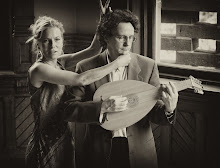
Here are the program and notes for the A Sa Lyre concert, Sat. 16th of Apr. at Heliconian Hall in Toronto. Hallie will be singing and I'll be playing two lutes (one with the top string at A at 465, so very little and high, one in G at 465) and a little Renaissance guitar. The artist who painted Mary Magdelene playing a Jouissance vous donneray (you can see the music if you turn it upside down) is the famous Master of the Female Half-lengths. Then there is a picture of Hallie looking at some words, and me playing the little guitar, details in the notes.

Venes mes serfs et Bacchus adorons Clemens non Papa (c 1513-c 1556)
Ah Dieu que c’est estrange martire Adrien Le Roy
Jouissance vous donneray Claudin de Sermisy (c 1490-1562)
Psalm Tunes for Lute Le Roy
Pseaume CXXXIV – Les Commandemans de Dieu – Pseaume XLII
Tant que vivray Claudin
Je suis amour Le Roy
La Magdelena - Bass dance Pierre Blondeau?
D’out vient cela Claudin
Anchor che col partire Jean Paul Paladin
Tant que jestoys Le Roy
J'ay le rebours de ce que je souhaite Pierre Certon (c. 1510-72)
L'ennuy qui me tourmente Le Roy
Oyez tous amoureux Jacques Champion dit Mithou (1530-80)
Intermission

O ma dame Le Roy
Pour m’eslonger Certon?
Puis que nouvelle Le Roy
Secourez moy Claudin
Prelude-Secoures moy-Tant que viray Pierre Blondeau?
Si j'ay pour vous Claudin
Pavane la Milanoise-Galliarde Guillaume Morlaye
Puis que malheur me tient Thomas Crequillon (c 1500-57)
Lute dances Le Roy
Pavan Est il conclud/Galliard Est il conclud/Branles des Bourgoignes
C’est a grand tort Crequillon
Le Petite enfant amour Guillaume Tessier
The publisher Pierre Attaingnant had already had success with books of dance music and chansons in four parts when in 1529 he printed a book of arrangements called Tres breve et familiere introduction pour entendre & apprendre par soy mesmes a jouer toutes chansons reduictes en la tabulature du Lutz. The lute’s popularity rose quickly in France in the early 1500’s thanks to its identification with the Classical lyre and, as the title page states, there is a didactic angle to the book - there are instructions for how to tune the lute and read the tablature. Claudin’s chansons are heavily represented in the print and we offer a selection of his settings of poems mostly by Clément Marot. In setting the anonymous poem Si j’ay pour vous Claudin quotes himself at the words ‘Secourez moy’. Overleaf from the voice and lute version of each song, Attaingnant gives a lute solo arrangement and he prints anonymous preludes at the beginning of the volume.
As well as those to his lute and his lyre (which turns out to be a lute in the last couple of verses) the great poet Pierre Ronsard addresses an ode A sa Guiterre. The guitar was a very diminutive instrument in this period, having four courses and, since it is not much bigger than a violin, being tuned a fourth higher than later guitars. There was a sudden flurry of printing for this instrument in France beginning around 1550. After a first book of solos Adrian Le Roy printed his Second livre de guittere, contenant plusieurs chansons en forme de voix de ville. The very courtly poetry (Pour m’eslonger and Puisque nouvelle and others in the book are by the Poet Laureate Saint-Gelais) is set to attractive, folksy melodies or based on popular stock chord progressions (L’ennuy is on the Spagnoletta bass). Many are dances; L’ennuy and Puisque nouvelle are Gaillardes, J’ay le rebours is a Pavanne, O ma dame is a Branle de Poitou). In all of the accompaniments the guitar plays a decorated version of the tune while the singer sings a simple version, suggesting that the player might chose to perform the piece as a guitar solo if he pleased.
Also in the voix de ville form are the airs from Le Roy’s book Livre d’Airs de Cour Miz sur le Luth of 1571. Though these, too, have the charming melodies and naïve doubling of the singing part, the courtly poets Ronsard (Je suis amour and Tant que j’estoys, Ronsard’s adaptation of an ode by the Roman Horace) and Desportes (Ah Dieu que c’est) are represented in the settings. We can safely say that such poetry is unlikely to have been sung by a plebian on a street corner in the Ville de Paris.
Pierre Phalèse printed several extraordinarily popular editions of his Hortus Musarum in the 1560s and 70s. We can see the repertoire, aimed at the burgeoning bourgeoisie of the Low Countries, develop over the course of the editions as the anthologist keeps up with the latest pan-European prints; The chansons of Crequillon and Clemens dominate in the early books.
Tessier set Ronsard’s poem about Love being stung by a bee for four voices in his book of 1582. The tune became the model for one of Philip Sidney’s songs from his Astrophel and Stella, and Tessier’s music was published in lute song version of Sidney’s In a grove most rich of shade. We sing Ronsard’s words to Robert Dowland’s arrangement of Tessier’s version.







